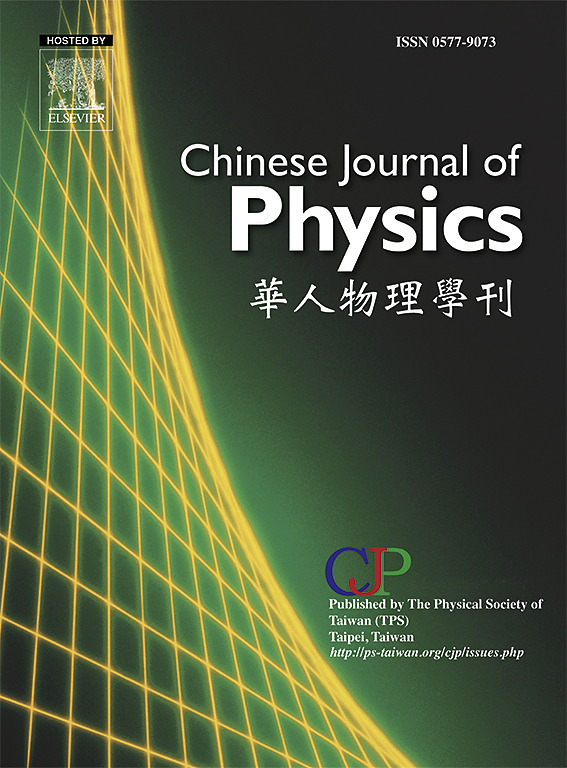探索液相剥离结合溶剂热合成硼罗芬纳米片在电化学传感中创新铅汞离子检测中的潜力
IF 4.6
2区 物理与天体物理
Q1 PHYSICS, MULTIDISCIPLINARY
引用次数: 0
摘要
在这项研究中,我们使用液相剥离和溶剂热法合成了少层,大片状的硼罗芬纳米片。通过傅里叶变换红外光谱(FTIR)、x射线衍射(XRD)、扫描电镜(SEM)和透射电镜(TEM)等多种技术对合成的硼罗芬进行了表征,研究了其结构和形态特性。为了更好地理解硼罗芬与重金属离子之间的相互作用机制,我们进行了密度泛函理论(DFT)计算。优化的结构、前沿分子轨道分析和分子静电势图为Pb (II)、Hg (II)和硼罗芬表面之间的超分子相互作用的本质提供了有价值的见解。我们还利用循环伏安法(CV)和差分脉冲伏安法(DPV)检测了硼罗芬修饰的玻碳电极(GCEs)的电化学性能。结果表明,该方法对Pb (II)和Hg (II)离子均具有较宽的线性响应范围(0.1 ~ 100 μM)和极低的检出限(0.1 μM)。这些发现表明硼罗芬修饰的gce作为检测重金属离子的高灵敏度和选择性平台的潜力,与传统的分析技术相比具有显著的优势。使用循环伏安法(CV)和差分脉冲伏安法(DPV)进行估计。该传感器线性响应范围宽(0.1 ~ 100 μM),对Pb (II)和Hg (II)离子的检出限极低(0.1 μM)。这些结果证明了bps修饰的gce作为一种高灵敏度和高选择性的重金属离子检测平台的潜力,与传统的分析技术相比具有显著的优势。本文章由计算机程序翻译,如有差异,请以英文原文为准。

Exploring the potential of liquid phase exfoliation combined solvothermal synthesis of borophene nanosheets for innovative lead and mercury ion detection in electrochemical sensing
In this study, we synthesized few-layered, large-flake borophene nanosheets using a liquid-phase exfoliation and solvothermal method. We characterized the synthesized borophene through various techniques, including Fourier-transform infrared spectroscopy (FTIR), X-ray diffraction (XRD), scanning electron microscopy (SEM), and transmission electron microscopy (TEM), to investigate its structural and morphological properties. To better understand the interaction mechanisms between borophene and heavy metal ions, we conducted density functional theory (DFT) calculations. The optimized structures, frontier molecular orbital analysis, and molecular electrostatic potential maps provided valuable insights into the nature of the supramolecular interactions between Pb (II), Hg (II), and the borophene surface. We also examined the electrochemical performance of borophene-modified glassy carbon electrodes (GCEs) using cyclic voltammetry (CV) and differential pulse voltammetry (DPV). The results showed a wide linear response range (0.1–100 μM) and a remarkably low detection limit of 0.1 μM for both Pb (II) and Hg (II) ions. These findings demonstrate the potential of borophene-modified GCEs as a highly sensitive and selective platform for detecting heavy metal ions, offering significant advantages over traditional analytical techniques. Estimated using cyclic voltammetry (CV) and differential pulse voltammetry (DPV). The sensor exhibited a wide linear response range (0.1–100 μM) and a remarkably low detection limit of 0.1 μM for Pb (II) and Hg (II) ions. These results demonstrate the Potential of BPS-modified GCEs as a highly sensitive and selective platform for heavy metal ion detection, offering significant advantages over traditional analytical techniques.
求助全文
通过发布文献求助,成功后即可免费获取论文全文。
去求助
来源期刊

Chinese Journal of Physics
物理-物理:综合
CiteScore
8.50
自引率
10.00%
发文量
361
审稿时长
44 days
期刊介绍:
The Chinese Journal of Physics publishes important advances in various branches in physics, including statistical and biophysical physics, condensed matter physics, atomic/molecular physics, optics, particle physics and nuclear physics.
The editors welcome manuscripts on:
-General Physics: Statistical and Quantum Mechanics, etc.-
Gravitation and Astrophysics-
Elementary Particles and Fields-
Nuclear Physics-
Atomic, Molecular, and Optical Physics-
Quantum Information and Quantum Computation-
Fluid Dynamics, Nonlinear Dynamics, Chaos, and Complex Networks-
Plasma and Beam Physics-
Condensed Matter: Structure, etc.-
Condensed Matter: Electronic Properties, etc.-
Polymer, Soft Matter, Biological, and Interdisciplinary Physics.
CJP publishes regular research papers, feature articles and review papers.
 求助内容:
求助内容: 应助结果提醒方式:
应助结果提醒方式:


